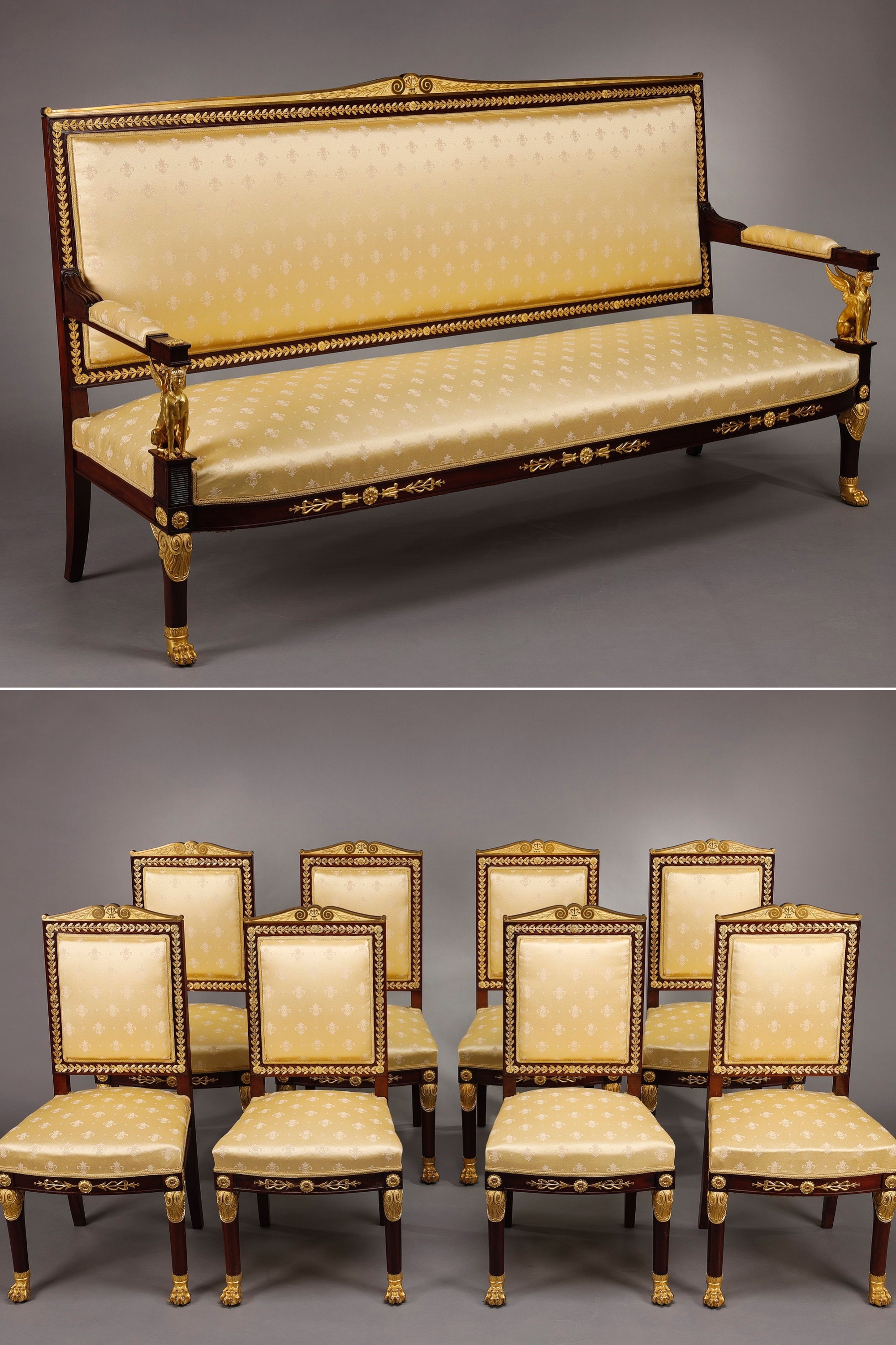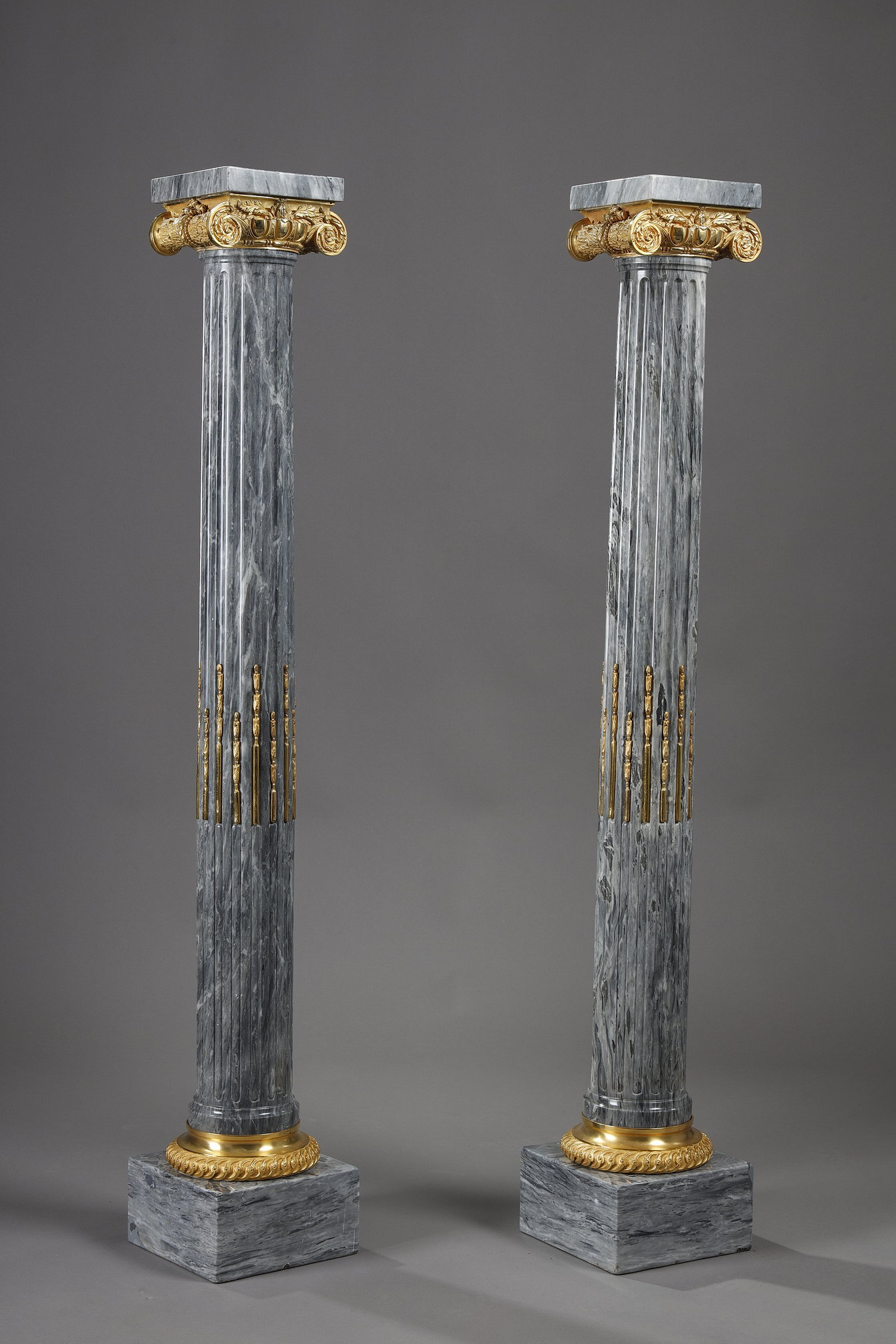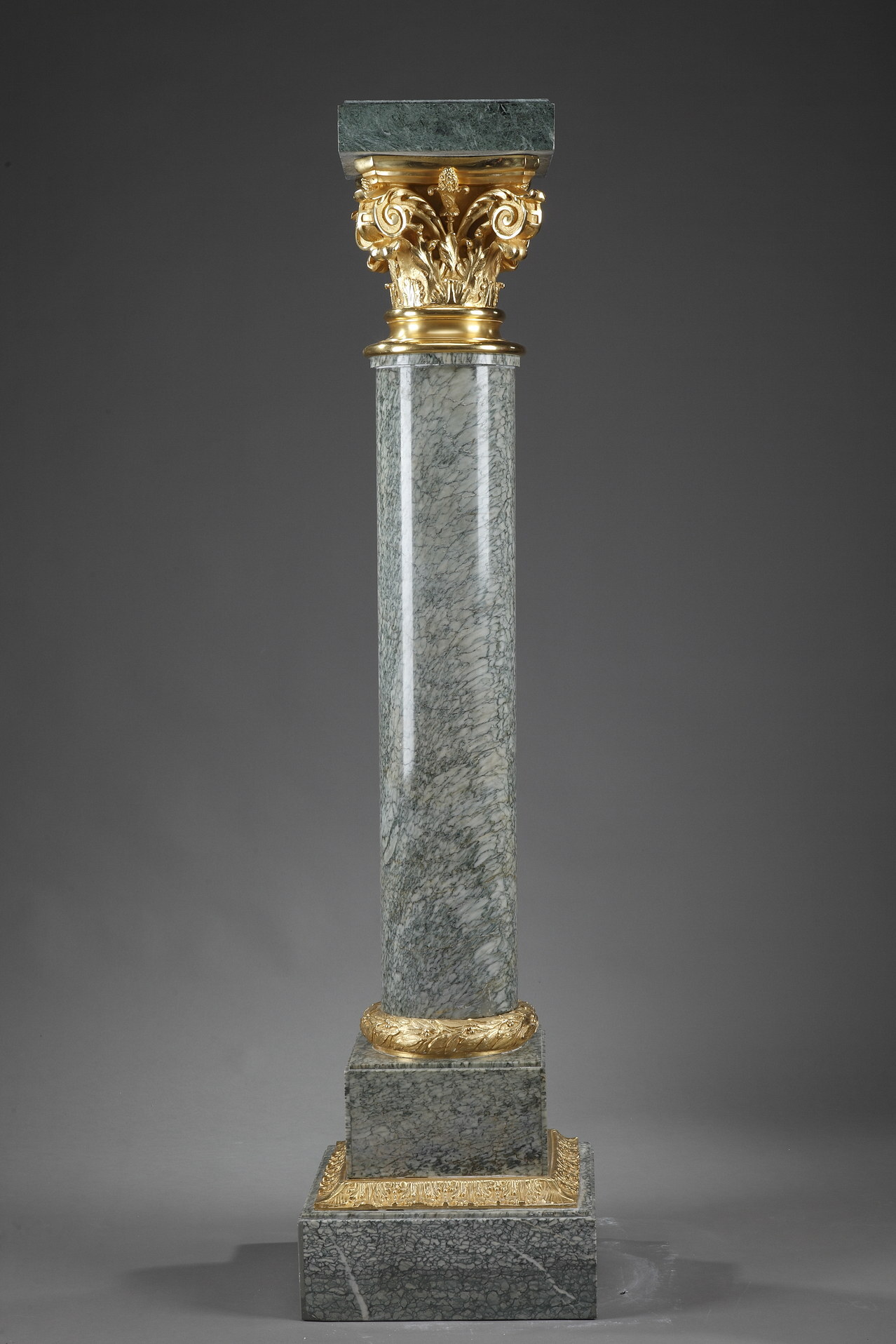Empire-style ornamentation
14.11.22
The Empire style, a propaganda style
At the end of the 18th century, Ancient Rome was celebrated both for its political grandeur and for what could be considered the apogee of aesthetics and its canons of ideal beauty. It was Napoleon I (1804-1815) who, out of a need to establish the new monarchy, gave birth to this severe, imposing style, where furniture was enhanced by antique symbols applied in gilded bronze. The Empire style by blending noble materials and antique emblems, quite simply put art at the service of power.
Empire-style mahogany and gilt bronze salon
Interior furnishings
To define the contours of this new " Empire style ", Napoleon appointed Charles Percier (1764-1838) and Pierre-François-Léonard Fontaine (1762-1853 ) as government architects. They organized all the arts of the Empire and redecorated the official residences. Furniture was veneered in mahogany for the grandest residences, or more modestly crafted in native woods such as walnut, elm, ash and golden beech, sometimes stained "mahogany-style" for middle-class residences.
How to recognize the Empire style?
Collection of interior decorations published in 1801 and 1812. Napoleon's architects also enriched their vision of antiquity, discovered on their various trips to Rome. Other influential ornamentalists and designers, such as Jean-Démosthène Dugourc (1749-1825) with his marked taste for Antiquity, or La Mésangère with his collections "Collection de meubles et objets de goût are well known to us. Most of these decorative elements are based on Greco-Roman ornamental vocabulary, but many also use Egyptian, plant, geometric and animal motifs.
Ornamentation motifs
Greco-Roman motifs

- Winged Victory
In the Roman Empire, Victory was considered the Emperor's personal goddess. In ornamentation, she is often depicted winged, holding a laurel wreath and blowing a trumpet.
- The trophy (Greco-Roman motif)
Ornamental motif formed by a mass of weapons and armor, such as quivers, swords, helmets, spears, breastplates, etc. The motif most often represents falling objects. The motif most often represents falling objects. By analogy, the name "trophy" is given to an ornamental grouping of various attributes, such as musical instruments or any other object representing a particular art or field. The trophy, a symbol of power, can be found on consoles, sconces or even collector's items such as inlaid wooden boxes.
- Bow and arrow (Greco-Roman motif)
This decorative element originated in the Roman Empire. Indeed, in ancient Rome, bows and arrows were considered a powerful weapon from the very beginnings of the Empire, and were held in the hands of emperors and gods. They thus became the symbol of Roman imperial power. Napoleon's "Empire style" continued to use this ornamental motif as a yardstick to measure up to the grandeur of Ancient Rome.
- The swan
It was Empress Josephine's favorite motif. We know that she brought two black swans from Australia as part of the "Voyage aux terres australes" expedition, and successfully bred them in captivity. Very attached to this delicate animal, it was only natural that she should feature it on her coat of arms.
- The lion's head (known as Musequin)
Lion's head with a ring in its mouth, usually used as a drawer handle, etc. The lion is a symbol of strength, power and sovereignty. It is often depicted as the guardian of the gates of palaces and temples, so featuring it on closed furniture makes perfect sense.
- Egyptian bust
This representation of an Egyptian bust flanked by a sheath appeared well before Napoleon's Egyptian campaign (1788-1790), i.e. towards the end of the reign of Louis XVI (1754-1793). This ornament was used in abundance during the Directoire and Empire styles, becoming characteristic of the latter.
- The sphinx
A woman with the body of a lion, in ancient Greece, the sphinx was considered a source of enigmatic wisdom. She is represented with the head and chest of a woman, the body of a lion and sometimes wings. In Empire furniture, she often takes up residence in the corners.
Plant motifs
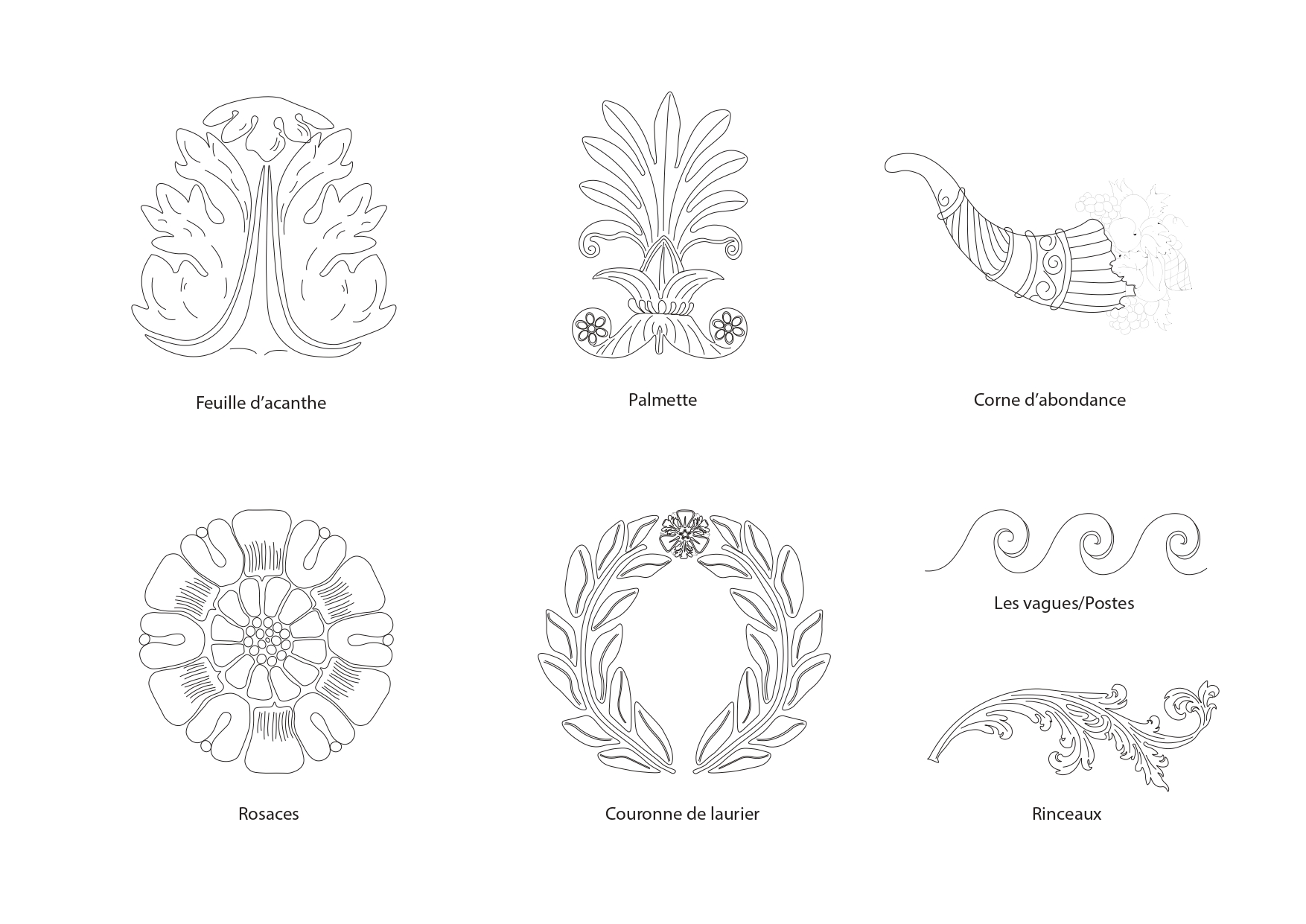
- Acanthus leaves and scrolls of acanthus leaves (Greco-Roman motif)
The Mediterranean flower, with its ribbed, indented leaves, has inspired a host of ornamental designs since Antiquity, and is an essential element of ornamentation. From the middle of the 5th century onwards, soft or cultivated acanthus became the main motif of Corinthian capitals. It is represented in its wild, stylized or realistic form. Widened and indented under Louis XV, it became simpler under Louis XVI, becoming more similar to ache, celery, thistle or parsley. In its "rinceau" form, it is sculpted as an undulating branch in the hollows of which alternate scrolling secondary branches are grafted. This type of ornamentation was invented in Greece, but has been used since then in every era.
- Palmette (Greco-Roman motif)
This Egyptian plant motif is made up of elongated lobes arranged in a fan shape. It was inspired by the palm leaf. The palmette is the ornament par excellence of Empire furniture, and is used in the composition of anthemions, repetitive motifs forming friezes.
- Cornucopia ( Greco-Roman motif)
It's a horn filled with flowers, fruit and leaves. This motif has its origins in Greek mythology. Zeus, who was taken in by a nymph at birth, was fed by a goat namedAmalthée. One day, while playing, Zeus broke one of the goat's horns and offered it to his nurse, promising that it would always be filled with all the fruit she desired. This element, symbolizing profusion, is much appreciated on clocks and bronzes.
- The waves
A linear pattern of undulating ribbons representing living water, it is used on chased bronze objects as a belt ornament.
- The rosettes
This plant motif depicts a large flower whose petals are arranged in concentric circles. It is most often represented with 6 lobes in the Empire style.
- The laurel wreath
An attribute of Apollo, the laurel first symbolized poetic glory, then became the Roman symbol of athletic success and military victory. The Empire stylestyle, like the Louis XVII style before it, made this motif one of its favorite decorative elements.
Geometric patterns

- Godrons, oves and sting
The godron is an elongated, swollen motif with a rounded end that, as with fluting, can be separated by leaves. Ovas and darts are found alternately as architectural ornaments. In Empire furniture, they are used as contour motifs.
- Grapes (Greco-Roman motif)
This repeating motif features alternating interlocking leaves in which the central rib forms the shape of a heart. The heart shape may be accompanied by a secondary motif such as a palmette.
- Interlacing
Like rais de cœur, godrons, oves and dards, this motif of intersecting lines in curves and volutes is defined as a frieze motif, most often adorning the belts of Empire-style furniture.
Columns and orders
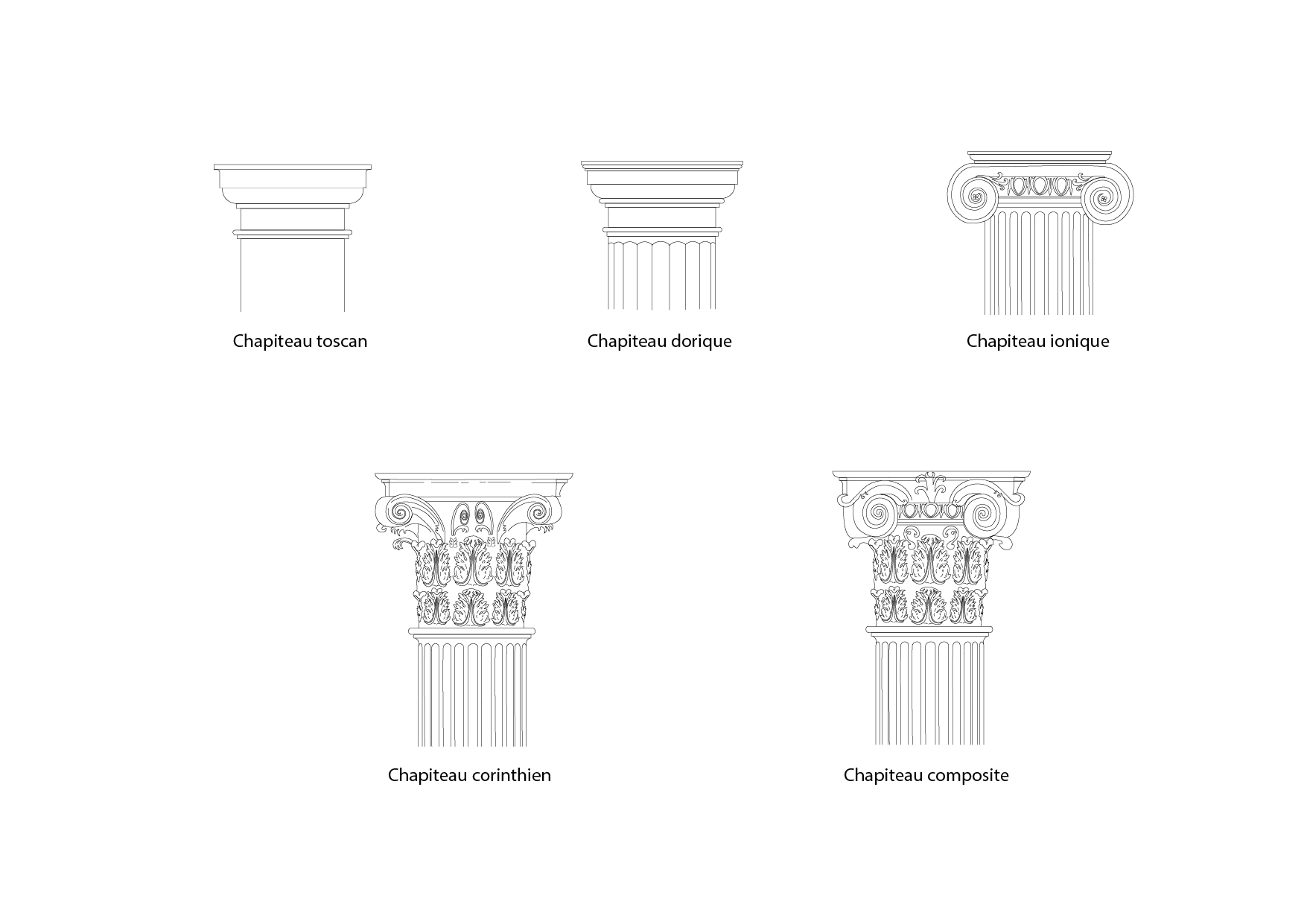
The Empire style also borrowed from Greco-Roman architecture, and columns with capitals made their appearance in furniture and furnishings: straight, with fluted shafts, embellished with gilded bronze laurels or gilded metal capitals and bases, Empire columns also appropriated Greek architectural orders. However, Napoleon's architects didn't hesitate to compose, mixing smooth shafts and molded capitals, sometimes flouting ancient conventions. This is probably one of the reasons why the reintroduction of antique-style columns in furnishings was so successful, and why they were produced until the end of the 19th century.
- The Tuscan order
This is a sober Roman order, with a smooth column shaft and a spine borrowed from the contemporary Greek Doric order.
- The Doric order
This is the oldest order (found in the Parthenon in Athens), consisting of a column with a fluted shaft and a capital decomposed from bottom to top. The word "Doric" comes from Dorôs son of Hellen who, according to Vitruvius, invented this order. We have a pair of Doric saddles that illustrate this order.
- The ionic order
This order originated in Ionia (Asia Minor), where we have numerous examples. The column is slender, the shaft fluted and the capital characterized by a scrolled cushion between the plate and the shaft (the echinus and abacus), as well as by a capital marked with a net of pearls and motifs of oves and darts. Our pair of gray veined marble saddles with Ionic capitals is a good example.
- The Corinthian order
This order, which originated in Corinth, is characterized by a capital adorned with acanthus leaf moldings that form a double crown, as well as fleuron and helix motifs. The Corinthian capital being the most richly decorated, it was used as a model from the Renaissance onwards, and of course under the Empire. This important column from the late 19th century is a perfect example.
- The composite order
This is an alteration of the Corinthian order, with a superimposition of Doric, Ionic and Corinthian orders. The base is Ionic, the shaft Doric and the capital Ionic (with its scrolls) and Corinthian (with its acanthus leaves). Our large pair of pink marble composite columns is a good example of this order.
The Empire style took hold, imposing itself on furniture with its rigid appearance, straight lines and, above all, bronze ornamentation. Symmetrical, Empire furniture is straight and solid, made of mahogany or mahogany veneer and gilded bronze ornaments, matt or shiny and chased. Empire-style desks, cabinets, armchairs and pendulum clocks are always adorned with decorative elements from the antique repertoire. The renewed appeal of this style in recent times has made it a must-have on the art and antiques markets.
Bibliography :
THOMAS Évelyne, Vocabulaire illustré de l'ornement, par le décor de l'architecture et des autres arts, Paris, Éditions Eyrolles, 2016.
DERROITTE Luc, Dictionnaire de l'Ornement, Paris, Éditions Jean-Paul Gisserot, 2012


